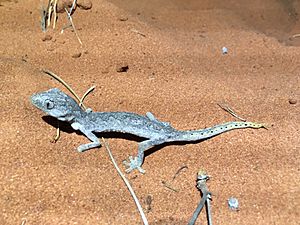Northern spiny-tailed gecko facts for kids
The northern spiny-tailed gecko (Strophurus ciliaris) is a unique lizard found only in Australia. It's known for its special "spiny tail" and the cool spines above its eyes that look like eyelashes! This gecko is a master of disguise, blending into its surroundings, and has some amazing ways to protect itself from predators.
Quick facts for kids Northern spiny-tailed gecko |
|
|---|---|
 |
|
| Conservation status | |
| Scientific classification | |
| Genus: |
Strophurus
|
| Species: |
ciliaris
|
| Synonyms | |
|
|
Contents
What's in a Name?
The scientific name of this gecko is Strophurus ciliaris. The word strophurus means "turning-tail." This refers to how these geckos can move their tails. The word ciliaris means "eyelashed," which points to the cool spines above their eyes.
Appearance and Features
Northern spiny-tailed geckos come in many different colors. They can be a plain gray with a few black or orange spots. Or, they might be a rich brown with patterns of gray, white, and orange.
They have spines along their tails. The long spines above their eyes really do make them look like they have eyelashes! These geckos are usually about 89 millimeters (about 3.5 inches) long. Female geckos are often bigger than the males.
Reproduction and Life Cycle
The northern spiny-tailed gecko is an oviparous species. This means that the females lay eggs instead of giving birth to live young. Each time, a female gecko usually lays two eggs.
Amazing Defenses
These geckos have some super cool ways to protect themselves!
- Tail Squirt: Geckos in the Strophurus family can squirt a harmless, smelly fluid from their tails. They do this to scare away birds and other animals that might try to eat them. This trick works best when they are resting in bushes.
- Bright Mouth Color: Another defense is their bright mouth color. When threatened, they open their mouths wide to show off a flash of bright color. This can surprise a predator and give the gecko time to escape.
Where They Live and What They Do
The northern spiny-tailed gecko is mostly nocturnal, meaning it is active at night. However, you might sometimes see them warming up in the sun during the day. They are arboreal, which means they live in trees and shrubs.
You can find them in dry, semi-dry, and subtropical areas. They often live in shrubland and can also be found hiding in clumps of spiky spinifex grass.
What They Eat
Scientists are still learning a lot about what the northern spiny-tailed gecko eats. Like many other geckos, they likely eat arthropods, which include insects and spiders. They have also been seen licking sap from wattle trees.
Where They Are Found
The northern spiny-tailed gecko lives in the middle of Australia. Their home range stretches across many states and territories. You can find them from the northwest of New South Wales and western Queensland. Their range continues through South Australia and the Northern Territory, and then into Western Australia.
Types of Northern Spiny-Tailed Geckos
There are two main types, or subspecies, of the northern spiny-tailed gecko. One type lives in the desert, and the other lives in tropical areas. These two subspecies are called Strophurus ciliaris ciliaris and Strophurus ciliaris aberrans.
Conservation Status
The northern spiny-tailed gecko is currently listed as "Least Concern" by the IUCN Red List. This is good news! It means they are not in immediate danger. They live in many different places and can adapt to various habitats. There are also not many big threats to this species right now.
Some of their habitat has been changed or damaged by things like land clearing and animals like goats. However, because these geckos are found over such a wide area, this is not a major problem for them at the moment.
Images for kids



